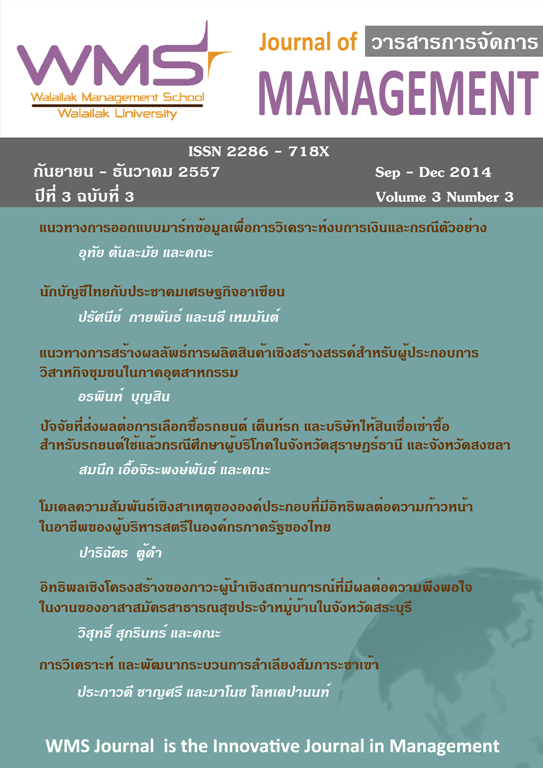The Causal Model of Career Advancement for Female Executives in Thai Public Organization
Main Article Content
Abstract
This research aimed to develop a structural equation model of career advancement for women executives in Thai public organization. The research samples were 640 women ordinary civil servants selected using multi-stage sampling. Data was significantly statistical analyzed by using LISREL program. The results indicated the developed model was valid and fitted to empirical data (c2=558.48, df=227, c2/df=2.46, CFI=0.99, GFI=0.93, RMSEA=0.048, SRMR=0.034). Human capital, family factor, organizational factor, job characteristics factor, gender-role attitudes, career commitment and self-efficacy were described 71 percent of the variance of career advancement. Organizational factor was the highest direct effect on career advancement at significant level .05 with effect sizes of 0.45 while job characteristics factor was the highest indirect effect with effect sizes of 0.44 as well.
Article Details
References
จำนง อดิวัฒนสิทธิ์. 2532. สังคมวิทยา. กรุงเทพฯ: สำนักพิมพ์จุฬาลงกรณ์มหาวิทยาลัย.
สมเกียรติ วันทะนะ. 2544. อุดมการณ์ทางการเมืองร่วมสมัย. กรุงเทพฯ: มหาวิทยาลัย
เกษตรศาสตร์ คณะสังคมศาสตร์ ภาควิชารัฐศาสตร์และรัฐประศาสนศาสตร์
สำนักงานข้าราชการพลเรือน. 2554. กำลังคนภาครัฐ 2554: ข้าราชการพลเรือนสามัญ. กรุงเทพฯ: ธีรานุสรณ์การพิมพ์.
Arokiasamy, L., Ismail, M., Ahmad, A., & Othman, J. 2011. Predictors of academics’ career advancement at Malaysian private universities. Journal of European Industrial Training, 35 (6), 589-605.
Aryee, S., Chay, Y.W. & Tan, H. H. 1994. An examination of the antecedents of subjective career success among a managerial sample in Singapore. Human Relations, 47(5), 487-509.
Aycan, Z. 2004. Key success factors for women in management in Turkey. Applied Psychology: An International Review, 53 (3), 453-477.
Ballout, H. I. 2009. Career commitment and career success: Moderating role of self-efficacy. Career Development International, 14(7), 655-670.
Day, R. & Allen, T. D. 2004. The relationship between career motivation and self-efficacy with protégé career success. Journal of Vocational Behavior, 64, 72-91.
Field, A. 2005. Discovering statistics using SPSS. 2nd ed. Thousand Oaks, CA: Sage Publication.
Hair, J. F., Black, W. C., Babin, B. J., & Anderson,R. E. 2010. Multivariate data analysis: A global perspective. 7th ed. Upper Saddle River, NJ: Prentice Hall.
Haspels, N. & Majurin, E. 2008. Work, income and gender equality in East Asia: Action guide. Bangkok: ILO.
Iles, P., Mabey, C. & Robertson, I. 1990. HRM practices and employee commitment: Possibilities, pitfalls and paradoxes. British Journal of Management, 1(3), 147-157.
International Labour Organization. 2004. Breaking through the glass ceiling: Women in management. Geneva: ILO.
Kline, R. B. 2011. Principles and practice of structural equation modeling. 3rd ed. New York: The Guilford Press.
Nabi, G. R. 2001. The relationship between HRM, social support and subjective career success among men and women. International Journal of Manpower, 22(5), 457-474.
Newstrom, J. W. 2011. Organizational behavior: Human behavior at work. 13th ed. New York: McGraw-Hill.
NG, T. W. H., Eby, L. T., Sorensen, K. L. & Feldman, D. C. 2005. Predictors of objective and subjective career success: A meta-analysis. Personnel Psychology, 58, 367–408.
Renzetti, C. M. & Curran, D. J. 2002. Women, men, and society. (5th ed.). Boston: Pearson Education.
Valcour, M. & Ladge, J. J. 2008. Family and career path characteristic as predictors of women’s objective and subjective career success: Intergrating traditional and protean career explanations. Journal of Vocational Behavior, 73, 300-309.


